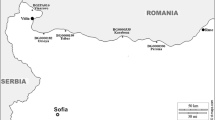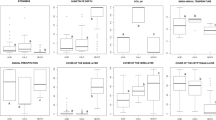Abstract
Bryophytes are important elements of plant communities in most habitat types worldwide. However, due to their relatively small size and difficult identification, bryophyte data are missing in many plant community studies. The objective of the present study is to increase the knowledge about EU Habitat directive bryophyte species distribution and conservation in Latvia. We compiled data from the Natural Data Management System OZOLS database about four EU Habitat Directive bryophyte species: Buxbaumia viridis, Dicranum viride, Hamatocaulis vernicosus and H. lapponicus, all indicators of high–value habitats in Latvia. The most common EU Habitat Directive species in this group was Buxmaumia viridis, which showed a significantly higher occurrence in the Western taiga habitat. Most of Hamatocaulis lapponicus and H. vernicosus localities were registered in protected areas with a high and moderate degree of protection. Most of Buxbaumia viridis and Dicranum viride localities were registered outside of the protected areas with a low degree of protection. Our results showed that EU Habitat Directive bryophyte species conservation in the long–term in Latvia is unclear, especially for B. viridis and D. viride populations. In future studies, we recommend initiating large-scale protected bryophyte monitoring programs and population studies that could contribute to plant community and global climate change research.














Similar content being viewed by others
References
Åberg SC, Korkka-Niemi K, Rautio A, Åberg AK (2022) The effect of river regulation on groundwater flow patterns and the hydrological conditions of an aapa mire in northern Finland. J Hydrol Reg Stud 40. https://doi.org/10.1016/j.ejrh.2022.101044
Abolin AA (1968) The mosses of Latvian SSR. Zinatne, Riga (In Russian; abstract in German)
Āboliņa A (1994) Latvijas retās un aizsargājamās sūnas. LU Ekoloģiskā centra apgāds Vide, Riga (In Latvian)
Āboliņa A, Piterāns A, Bambe B (2015) Latvijas ķērpji un sūnas. Taksonu saraksts (Lichens and bryophytes in Latvia. Checklist). Daugavpils Universitātes akadēmiskais apgāds Saule, Daugavpils (In Latvian; abstract in English)
Apinis A, Lācis L (1936) Data on the ecology of bryophytes II. Acidity of the substrata of musci. Acta Horti Bot Univ Latv 9(10):1–100
Auniņš A, Auniņa L, Bambe B et al (2013) Eiropas Savienības aizsargājamie biotopi Latvijā. Noteikšanas rokasgrāmata. 2. precizēts izdevums. Noteikšanas rokasgrāmata. 2. precizēts izdevums. Latvijas Dabas fonds, Vides aizsardzības un reģionālās attīstības ministrija, Riga (In Latvian)
Baisheva EZ, Mežaka A, Shirokikh PS, Martynenko VB (2013) Ecology and distribution of Dicranum viride (Sull. Lesq.) Lindb. (Bryophyta) in the southern Ural Mts. Arctoa 22(1):41–50. https://doi.org/10.15298/arctoa.22.07
Bambe B (2002) Dabas lieguma “Pilskalnes Siguldiņa” brioflora. Mežzinātne 11(44):111–124 (In Latvian)
Bambe B, Baroniņa V, Suško U (2022) Spīdīgās āķītes Hamatocaulis vernicosus (Mitt.) Hedenäs izplatība un populāciju dinamika Latvijas Natura 2000 teritorijās. Latvijas Veģetācija 49–63 (In Latvian; abstract in English)
Council Directive 92/43/EEK (1992) On the protection of natural biotopes, wild plants and animal species. Annex II, Annex V. OJEU 22. 7. 92. No L 206:7–50
Deme J, Erzberger P, Kovács D, Tóth IZ, Csiky J (2020) Buxbaumia viridis (Moug. ex Lam. & DC.) Brid. ex Moug. & Nestl. In Hungary predominantly terricolous and found in managed forests. Cryptogam Bryol 41(8):89–103. https://doi.org/10.5252/cryptogamie-bryologie2020v41a8
European Commission (2007a) Online report on Article 17 of the Habitats Directive: conservation status of habitats and species of Community interest (2001−2006), Plants. https://bd.eionet.europa.eu/article17/index_html/speciesreport/?group=UGxhbnRz&country=LV®ion. Accessed 15 Dec 2022
European Commission (2007b) Latvia 2001–2006. Report on progress and implementation (Article 17, Habitats Directive). https://cdr.eionet.europa.eu/lv/eu/art17/envrgdigq/index_html?&page=94. Accessed 25 May 2023
European Commission (2013) Latvia 2007–2012. Factsheet. Annex B–Reporting format on the 'main results of the surveillance under Article 11 for Annex II, IV & V species. https://cdr.eionet.europa.eu/Converters/run_conversion?file=lv/eu/art17/envuc1kdw/LV_species_reports-131018-113252.xml&conv=354&source=remote. Accessed 25 May 2023
European Commission (2019) Latvia 2013–2018. Factsheet. Annex B–Reporting format on the 'main results of the surveillance under Article 11′ for Annex II, IV & V species. https://cdr.eionet.europa.eu/Converters/run_conversion?file=lv/eu/art17/envxwalvg/LV_species_reports-20190829-115440.xml&conv=593&source=remote. Accessed 25 May 2023
Fojcik B, Chruścińska M, Nadgórska-Socha A (2017) Epiphytic habitats in an urban environment; contamination by heavy metals and Sulphur in the barks of different tree species. Pol J Nat Sci 32(2):283–295
Hallingbäck T, Tan BC (2010) Past and present activities and future strategy of bryophyte conservation. Phytotaxa 9. https://doi.org/10.11646/phytotaxa.9.1.15
Hedenäs L, Collart F, Heras P, Infante M, Kooijman A, Kučera J (2022) Distributions and habitats of the two partly allopatric cryptic species of the vulnerable moss Hamatocaulis vernicosus (Bryophyta) in Europe. Bot J Linn Soc 200:233–254
Hodgetts N, Lockhart N (2020) Checklist and country status of European bryophytes – update 2020. Irish Wildlife Manuals, No. 123. National Parks and Wildlife Service, Department of Culture, Heritage and the Gaeltacht, Dublin
Hodgetts NG, Söderström L, Blockeel TL et al (2020) An annotated checklist of bryophytes of Europe, Macaronesia and Cyprus. J Bryol 42:1–116. https://doi.org/10.1080/03736687.2019.1694329
Ignatov MS, Ignatova EA (2004) Flora mhof srednjei chastji Evropeiskoi Rossi T.2 Fontinalaceae–Amblystegiaceae. KMK Scientific Press, Moskva (In Russian)
Ignatova EA, Fedosov VE (2008) Species of Dicranum (Dicranaceae, Bryophyta) with fragile leaves in Russia. Arctoa 17(1):63–83. https://doi.org/10.15298/arctoa.17.05
Kalvaitienė M, Jukonienė I (2022) Habitat preferences of Hamatocaulis vernicosus at the junction of continental and boreal phytogeographical regions (Lithuania). Boreal Environ Res 27(1–6):81–96
Latvian Botanical Society (2015) Sūnu un lokanās najādes Najas flexilis monitorings atbilstoši Bioloģiskās daudzveidības monitoringa programmai. Latvijas Botāniķu Biedrība, Riga (In Latvian)
Latvijas Dabas Fonds (2021) Vaskulāro augu un sūnu sugu monitorings un inventarizācija Natura 2000 teritorijās un ārpus tām 2021. gadā. Latvijas dabas fonds, Riga (In Latvian)
Latvijas Republikas Ministru kabinets (2000) (LRMK 2000) Noteikumi par īpaši aizsargājamo sugu un ierobežoti izmantojamo īpaši aizsargājamo sugu sarakstu (grozījumi 27.07.2004 not. nr. 627). Noteikumi nr. 396. Latvijas Vēstnesis 413(417):4–6 (In Latvian)
Latvijas Republikas Ministru kabinets (2012) (LRMK 2012) Noteikumi par mikroliegumu izveidošanas un apsaimniekošanas kārtību, to aizsardzību, kā arī mikroliegumu un to buferzonu noteikšanu. Noteikumi nr. 940. Latvijas Vēstnesis 203(4806):1–30 (In Latvian)
Latvijas Republikas Ministru kabinets (2017) (LRMK 2017) Ministru kabineta 2017. gada 20. jūnija noteikumi Nr. 350 “Noteikumi par īpaši aizsargājamo biotopu veidu sarakstu”. Publicēts oficiālajā izdevumā “Latvijas Vēstnesis”, 27.06.2017., Nr. 126 https://www.vestnesis.lv/op/2017/126.17 (In Latvian). Accessed 20 June 2023
Latvijas Vides ģeoloģijas un meteoroloģijas centrs (2023) (LVĢMC 2023). Latvijas klimats. https://videscentrs.lvgmc.lv/lapas/latvijas-klimats. (In Latvian). Accessed 30 May 2023
Mežaka A, Brūmelis G, Piterāns A (2008) The distribution of epiphytic bryophyte and lichen species in relation to phorophyte characters in Latvian natural old–growth broad leaved forests. Folia Cryptogam Estonica 44:89–99
Mežaka A, Moisejevs R, Nitcis M (2021) The main drivers for the occurrence of six red–listed epiphytic bryophytes and lichens in the boreo–nemoral forest landscape, Latvia. Folia Cryptogam Estonica 58:229–241. https://doi.org/10.12697/fce.2021.58.22
Nature Conservation Agency (2022) (NCA 2022) Eiropas Savienības nozīmes biotopu tiesiskās aizsardzības Latvijā izvērtējums. Nature Conservation Agency, Sigulda (In Latvian)
Pētersone A, Birkmane K (1980) Latvijas PSR augu noteicējs. Latvijas Valsts izdevniecība, Riga
Plášek V (2004) The moss Buxbaumia viridis (Bryopsida, Buxbaumiaceae) in the Czech part of the Western Carpathians — distribution and ecology. In: Stebel A, Ochyra R (eds) Bryological studies in the Western Carpathians. Sorus, Poznań, pp 37–44
Pykälä J (2019) Habitat loss and deterioration explain the disappearance of populations of threatened vascular plants, bryophytes and lichens in a hemiboreal landscape. GECCO 18. https://doi.org/10.1016/j.gecco.2019.e00610
R Core Team (2021) R: A language and environment for statistical computing. R Foundation for Statistical Computing, Vienna. URL https://www.R-project.org/
Rehell S, Virtanen R (2016) Rich–fen bryophytes in past and recent mire vegetation in a successional land uplift area. Holocene 26:136–146. https://doi.org/10.1177/0959683615596831
Ruete A, Yang W, Bärring L, Stenseth NC, Snäll T (2012) Disentangling effects of uncertainties on population projections: climate change impact on an epixylic bryophyte. Proc Royal Soc B 279. https://doi.org/10.1098/rspb.2012.0428
Saeima (2000) Sugu un biotopu aizsardzības likums. Latvijas Vēstnesis. Nr. 121/122 (In Latvian) https://www.vestnesis.lv/ta/id/3941-sugu-un-biotopu-aizsardzibas-likums. Accessed 19 Jan 2023
Slack NG (2011) The ecological value of bryophytes as indicators of climate change. In: Tuba Z, Slack NG, Stark LR (eds) Bryophyte ecology and climate change. Cambridge University Press, Cambridge, pp 3–12
Söderström L, Hallingbäck T, Gustaffson L et al (1992) Bryophyte conservation for the future. Biol Conserv 59:265–270. https://doi.org/10.1016/0006-3207(92)90595-E
Štechová T, Kučera J (2007) The requirements of the rare moss, Hamatocaulis vernicosus (Calliergonaceae, Musci), in the Czech Republic in relation to vegetation, water chemistry and management. Biol Conserv 135:443–449. https://doi.org/10.1016/j.biocon.2006.10.021
Štechová T, Holá E, Manukjanová A, Mikulášková E (2010) Distribution and habitat requirements of the moss Hamatocaulis vernicosus (Mitt.) Hedenäs in the Bohemian Forest. Silva Gabreta 16(1):1–11
Uselienė A (2021) Žaliasis sėmainis. Buxbaumia viridis (Moug. ex Lam. & DC.) Brid. ex Moug. & Nestl. In: Rašomavičius V (ed) Red Data Book of Lithuania. Animals, plants, fungi. Leidykla Lututė, Vilnius, pp. 333–371 (In Lithuanian; abstract in English)
Valsts meža dienests (2023) (VMD 2023) Meža resursu statistikas dati (Data of forest resource statistics). https://www.zm.gov.lv/mezi/statiskas-lapas/nozares-informacija/meza-resursi?nid=1086#jump. (In Latvian). Accessed 21 Jan 2023
Wierzcholska S, Dyderski MK, Jagodziński AM (2020) Potential distribution of an epiphytic bryophyte depends on climate and forest continuity. Glob Planet Change 193. https://doi.org/10.1016/j.gloplacha.2020.103270
Wiklund K (2002) Substratum preference, spore output and temporal variation in sporophyte production of the epixylic moss Buxbaumia viridis. J Bryol 24:187–195. https://doi.org/10.1179/037366802125001358
Wiklund K (2003) Phosphorus concentration and pH in decaying wood affect establishment of the red-listed moss Buxbaumia viridis. Canad J Bot 81:541–549. https://doi.org/10.1139/b03-048
Zanatta F, Engler R, Collart F et al (2020) Bryophytes are predicted to lag behind future climate change despite their high dispersal capacities. Nat Commun 11. https://doi.org/10.1038/s41467-020-19410-8
Zechmeister HG, Kropik M, Popovtschak M, Scharrer-Liška G (2019) Bryophytes in a latrine as indicators of climate change in the 17th century. Veg Hist Archaeobot 28:575–581. https://doi.org/10.1007/s00334-019-00717-6
Acknowledgments
We are grateful to Joint Stock Company “Latvia’s State Forests” for co–operation. Thanks to Kristīne Sproģe for help with data about drainage ditches and to Gita Strode for the discussions about nature conservation in Latvia. We are grateful to two reviewers for important comments which helped to improve this article.
Funding
The study was financially supported by a postdoctoral grant: “Epiphyte metapopulation dynamics in boreo-nemoral forest landscape” (Nr. 1.1.1.2/VIAA/3/19/469).
Author information
Authors and Affiliations
Contributions
Conceptualization: Anna Mežaka; Methodology: Anna Mežaka; Formal analysis and investigation: Anna Mežaka, Anete Pošiva-Bunkovska, Māris Nitcis; Writing–original draft preparation: Anna Mežaka; Writing–review and editing: Anna Mežaka, Anete Pošiva-Bunkovska, Evita Oļehnoviča, Māris Nitcis, Baiba Bambe; Supervision: Anna Mežaka.
Corresponding author
Ethics declarations
The authors have no relevant financial or non–financial interests to disclose.
Additional information
Publisher’s note
Springer Nature remains neutral with regard to jurisdictional claims in published maps and institutional affiliations.
Supplementary Information
ESM 1
(DOCX 23 kb)
Rights and permissions
Springer Nature or its licensor (e.g. a society or other partner) holds exclusive rights to this article under a publishing agreement with the author(s) or other rightsholder(s); author self-archiving of the accepted manuscript version of this article is solely governed by the terms of such publishing agreement and applicable law.
About this article
Cite this article
Mežaka, A., Pošiva-Bunkovska, A., Oļehnoviča, E. et al. EU habitat directive bryophyte species distribution and conservation in Latvia. Biologia 79, 1193–1207 (2024). https://doi.org/10.1007/s11756-023-01571-8
Received:
Accepted:
Published:
Issue Date:
DOI: https://doi.org/10.1007/s11756-023-01571-8




